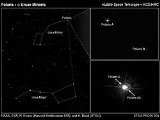
Polaris
Overview
Constellation
In modern astronomy, a constellation is an internationally defined area of the celestial sphere. These areas are grouped around asterisms, patterns formed by prominent stars within apparent proximity to one another on Earth's night sky....
Ursa Minor
Ursa Minor
Ursa Minor , also known as the Little Bear, is a constellation in the northern sky. Like the Great Bear, the tail of the Little Bear may also be seen as the handle of a ladle, whence the name Little Dipper...
. It is very close to the north celestial pole
Celestial pole
The north and south celestial poles are the two imaginary points in the sky where the Earth's axis of rotation, indefinitely extended, intersects the imaginary rotating sphere of stars called the celestial sphere...
, making it the current northern pole star.
Polaris is about 434 light-years from Earth and is a multiple star
Multiple star
A multiple star consists of three or more stars which appear from the Earth to be close to one another in the sky. This may result from the stars being physically close and gravitationally bound to each other, in which case it is physical, or this closeness may be merely apparent, in which case...
. It consists of the main star
UMi A, two smaller companions, UMi B and UMi Ab, and two distant components UMi C and UMi D. UMi B was discovered in 1780 by William Herschel
William Herschel
Sir Frederick William Herschel, KH, FRS, German: Friedrich Wilhelm Herschel was a German-born British astronomer, technical expert, and composer. Born in Hanover, Wilhelm first followed his father into the Military Band of Hanover, but emigrated to Britain at age 19...
.
UMi A is a six solar mass
Solar mass
The solar mass , , is a standard unit of mass in astronomy, used to indicate the masses of other stars and galaxies...
F7 bright giant (II) or supergiant (Ib).
Unanswered Questions

